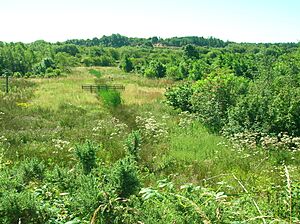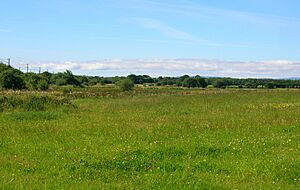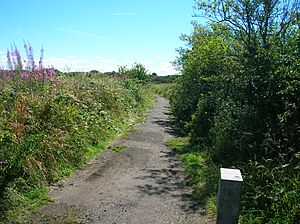Ardeer, North Ayrshire facts for kids
Quick facts for kids Ardeer |
|
|---|---|
| Population | 9,129 (2001 census) est. 8,990 (2006) |
| OS grid reference | NS282406 |
| Council area | |
| Lieutenancy area |
|
| Country | Scotland |
| Sovereign state | United Kingdom |
| Post town | STEVENSTON |
| Postcode district | KA20 |
| Dialling code | 01294 |
| Police | Strathclyde |
| Fire | Strathclyde |
| Ambulance | Scottish |
| EU Parliament | Scotland |
| UK Parliament |
|
| Scottish Parliament |
|
Ardeer was once a small town in Scotland, now part of Stevenston in North Ayrshire. It sits on the Ardeer peninsula, which used to be an island. This area became famous for the Nobel Explosives factory, which was a huge global supplier of explosives for mining and quarrying. It also played a big role in creating products for the chemical and defense industries in the 20th century.
Today, the Ardeer peninsula is one of the most important places in North Ayrshire for its amazing wildlife.
Contents
Geography of Ardeer
Ardeer as an Island
Long ago, Ardeer was actually an island! A sea channel ran through the area, exiting near Auchenharvie Academy. Old maps from the 1600s, like Blaeu's map from 1654, show Ardeer as a small island. Settlements like Ardeer, Dubbs, and Bartonholm were located on or near its coastline.
The Lugton Water river used to flow into the bay near Ardeer. Over time, the coastline changed a lot due to shifting sands. This might have blocked the sea channel, turning Ardeer from an island into a peninsula.
Even as late as 1902, people remembered small lochs or "dubbs" (ponds) between Kilwinning and Stevenston. This shows how much the water and land changed over the centuries.
The Ardeer Peninsula Today
By the late 1600s, Ardeer was no longer an island. Maps from that time show it as a peninsula, mostly covered in sand dunes. The River Garnock had also moved to its current path.
An old road, called the Knowes Road, followed the path of the former sea channel. It ran from Stevenston to Kilwinning. Another road, Inch Road, led directly to Misk, a small group of buildings on the peninsula. The name "Inch Road" might remind us that Ardeer was once a small island, as "inch" can mean a small island, especially in wet areas.
Patrick Warner, who owned the Ardeer estate, learned about land reclamation in Holland. In the late 1600s, he started draining the bogs (wetlands) by digging a main ditch called the Master Gott. This drainage system was later used for the Stevenston Canal.
The peninsula is also home to the abandoned building of The Big Idea. This museum celebrated Scottish inventions and inventors from 2000 to 2003. It has been empty since it closed in 2003.
History of Ardeer
Old Legends
There are some interesting old stories about Ardeer. One legend says that Saint Winning sent his monks to fish in the River Garnock. But they couldn't catch anything! Saint Winning got upset and cursed the river so it would never have fish. The river supposedly responded by changing its course to avoid the curse. We know the river has indeed changed its path a lot over time.
Another legend, told by Robin Campbell, is about the murder of the Earl of Eglinton's wife on Ardeer in the 1500s. The Earl disagreed with the monks of Kilwinning Abbey and stopped paying them money. In revenge, the Abbot (the head monk) arranged for the Countess of Eglinton to be captured on her way to Ardrossan. She was imprisoned in a ruined hut and starved to death. Her husband could never find her, but people reported hearing a woman's screams in the waves at Ardeer. Years later, the last monk of Kilwinning Abbey supposedly confessed to the crime, revealing the truth.
Ancient Finds
Many old objects have been found on the Ardeer peninsula. These include 54 flint arrowheads, 167 scrapers, and 24 knives. People also found a Bronze Age gouge (a tool), parts of beads, glass, and shale rings. There were also two Roman-British brooches and an Anglo-Saxon bronze strap end from the 10th century.
In 1906, shifting sand uncovered a small stone mound (cairn) that was about 15 feet by 10 feet. Inside, there were at least sixteen urns, which were used to hold ashes after cremation. Sadly, this site was destroyed when the Nobel factory was built.
Evidence suggests that farming took place on Ardeer long ago. When mining happened at Misk Colliery, rich soil was found with signs of ploughing. Even a tobacco pipe was found, showing that farming happened no earlier than the mid-1500s, when tobacco first came to Europe.
The Nobel Explosives Factory
The Ardeer peninsula became the home of a massive dynamite factory built by Alfred Bernhard Nobel. He searched all over the country for a remote place to build his factory. In 1871, Nobel bought about 100 acres of land from the Earl of Eglinton. He then built the British Dynamite Factory, which grew to be the largest explosives factory in the world.
The factory had its own jetty (a small pier) on the River Garnock in Irvine Harbour. This allowed ships to bring in materials for the factory or dispose of old explosives.
At its busiest, the factory employed almost 13,000 workers. It even had its own railway station, called Ardeer Platform. This station was only for workers and special visitors to the ICI plant. It was never a regular stop for the public. Until the mid-1960s, two trains ran daily to transport workers. The railway line is gone now, but the old platform is still there, hidden by plants.
Transport in Ardeer
Canals
The Stevenston Canal, built in 1772, was the first commercial canal in Scotland. It was just over two miles long and about 12 feet wide, with a depth of 4 feet. It didn't have any locks. Much of the canal followed the old path of the River Garnock, which was a leftover from when Ardeer was an island. The Master Gott drain is thought to be the last part of this old canal.
Coal was carried on barges along the canal. Waste from the coal mines was dumped along the route to create a windbreak, as blowing sand was a constant problem. The canal got its water from a dam on the Stevenston Burn.
Railways
In 1840, a station called Stevenston opened at Ardeer on the railway line from Ardrossan to Glasgow. Later, the Ardeer Platform railway station was built specifically for the many Nobel factory workers. It closed in 1966. Even earlier, by 1836, a horse-drawn wagonway (a simple railway) was built from Saltcoats to the coal pits in the area that is now Ardeer Park.
Sports in Ardeer
Ardeer Golf Club
The land owned by ICI used to be home to the Ardeer Golf Club. The first course had 9 holes in the Sandyhills area of Stevenston. Although that course is long gone, the original clubhouse, made of red sandstone, is still there.
The club then moved to the Ardeer area of Stevenston, and a new course opened in 1905. This course was a true seaside links course, built among the sand dunes between the town and the sea. Most of its members worked for ICI.
During the Second World War, three of the golf holes were taken over by ICI to be used as a barrage balloon station (for defense). After the war, these holes were restored.
However, in the early 1960s, the club faced a big change. ICI needed the golf course land to build a new factory for making salts used in the nylon industry. Since ICI owned the land, the golf club had no choice but to move again.
After several meetings, the club decided to rebuild at Lochend. Over the past 38 years, the course has been continuously improved by the hard work of its members and staff. Drainage has gotten better, allowing golf all year round. The course now has many mature and young trees, and it uses two small streams that flow through it.
Other Sports
An 1895 map shows a rifle range on the peninsula, with targets at different distances. In 1908, a cricket ground and pavilion were shown in the area where the old golf course used to be.
Education in Ardeer
Schools
Ardeer Primary School opened in August 1982. It is located in the Ardeer Area of Stevenston on Clark Crescent. The school serves children aged 5 to 11 and has a nursery class. The old Ardeer Primary School was on Garven Road and closed in late 1981.
Culture in Ardeer
Parish Church
In the middle of Ardeer is the Shore Road Ardeer Parish Church. It officially opened on June 14, 1895. The church is a beautiful red sandstone building from the early 20th century, built in the Gothic style. It has an octagonal (eight-sided) tower with battlements (like a castle wall) and small pinnacles at the corners.
Ardeer church currently has two ministers, Rev John Lafferty and Rev David Hebenton. They also serve Livingstone Parish Church, which is nearby.
Wildlife on Ardeer Peninsula
Before factories were built in the late 1800s, the Ardeer peninsula was mostly a huge system of moving sand dunes. It had a sandy beach on the west side and salt marshes and mud flats next to the River Garnock on the east. Even though the Nobel (and later ICI) factory changed many areas, the need to keep factory units far apart for safety meant that much of the natural area remained.
In recent years, sand has been removed from the area, causing 20 hectares of dunes to be lost. However, the southern half of the peninsula still looks much like it did originally. When the peninsula was studied in 2015, it was found to be the best place for wildlife in North Ayrshire. Part of the peninsula is a special protected area called a Site of Special Scientific Interest (Bogside Flats). The peninsula is also important because it's near two nature reserves: Garnock Floods (managed by the Scottish Wildlife Trust) and Bogside Reserve (managed by the RSPB).
Habitats
The side of the peninsula facing the sea has a concrete sea wall, built between 1926 and 1929. This wall has greatly reduced how much the sand dunes can move. However, it's breaking in some places, which might allow the dunes to become more mobile again.
The sand dunes make up most of the peninsula. In the southern half, they are still mostly natural. This area is mainly covered in acid dune grassland, with large sections of dune heath and dune slacks (wet hollows between dunes).
On the east side of the peninsula are the salt marshes and mudflats of the River Garnock estuary. These are part of the Bogside Flats SSSI. Some parts of the northern half of the peninsula were planted with pine trees in the mid-20th century. These forests have been left mostly untouched. This old pine forest is a rare habitat in southern Scotland and is special because it has a lot of dead wood, which is important for many creatures.
There has also been a lot of natural woodland growing in various places. These woods include birch, willow, alder, and sycamore trees.
Amazing Wildlife
About 1500 different species of living things have been found at Ardeer! Two-thirds of these are invertebrates (animals without backbones), making it one of the most important places for insects in Scotland. Bees, wasps, and beetles are especially notable here.
Ardeer is thought to be the best place in Scotland for solitary bees and wasps. This is because of the sandy ground and the many wildflowers. Some special species found here include the northern colletes bee, which is mostly found in the Hebrides in Scotland, and the hairy-saddled colletes bee, which is usually found in southern Britain.
Surveys of beetles at Ardeer have found 341 different species. Twenty-two of these are nationally rare or scarce. For example, the ground beetle Harpalus neglectus was recorded here for the first time in Scotland! Ardeer is also home to the impressive Minotaur beetle, Typhaeus typhoeus, which has its main home in the dunes of Ardeer and Irvine.
Ardeer has the largest populations in Ayrshire of the dark green fritillary and grayling butterflies. It also has several nationally scarce moths, like the coast dart and shore wainscot. Over 100 species of spiders have been recorded, with wolf spiders being very common. Half of all the wolf spider species on the Scottish list are found here!
Among the 122 species of birds recorded, the lesser whitethroat is very special. Ardeer has the largest breeding population of this bird in Ayrshire. Other notable birds seen here include the hen harrier, long-eared owl, osprey, and snow bunting. During migration and winter, the Garnock mudflats and estuary are important for many wigeon, greenshank, and other wildfowl and wading birds.
Threats to Wildlife
In the past, the safety rules for the explosives factory actually helped protect the habitats on the peninsula. However, the area is now facing two main threats. First, a special order from the UK government in 1953 still allows building developments to happen in Ardeer without the usual strict planning checks needed elsewhere in Scotland. Second, money has been given under the Ayrshire Growth Deal. This could lead to new businesses, houses, and recreational areas around the Irvine/Garnock estuaries. If this happens, it could mean a very big loss of habitats and many of the special species that live there.
|






